Pyraminx
The Pyraminx (/ˈpɪrəmɪŋks/) is a regular tetrahedron puzzle in the style of Rubik's Cube. It was made and patented by Uwe Mèffert after the original 3 layered Rubik's Cube by Erno Rubik, and introduced by Tomy Toys of Japan (then the 3rd largest toy company in the world) in 1981.[1]
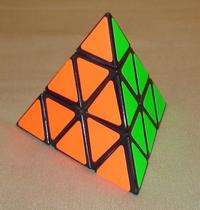
Description
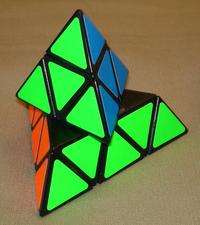
The Pyraminx was first conceived by Mèffert in 1970. He did nothing with his design until 1981 when he first brought it to Hong Kong for production. Uwe is fond of saying had it not been for Erno Rubik's invention of the cube, his Pyraminx would have never been produced.
The Pyraminx is a puzzle in the shape of a regular tetrahedron, divided into 4 axial pieces, 6 edge pieces, and 4 trivial tips. It can be twisted along its cuts to permute its pieces. The axial pieces are octahedral in shape, although this is not immediately obvious, and can only rotate around the axis they are attached to. The 6 edge pieces can be freely permuted. The trivial tips are so called because they can be twisted independently of all other pieces, making them trivial to place in solved position. Meffert also produces a similar puzzle called the Tetraminx, which is the same as the Pyraminx except that the trivial tips are removed, turning the puzzle into a truncated tetrahedron.

The purpose of the Pyraminx is to scramble the colors, and then restore them to their original configuration.
The 4 trivial tips can be easily rotated to line up with the axial piece they are respectively attached to, and the axial pieces are also easily rotated so that their colors line up with each other. This leaves only the 6 edge pieces as a real challenge to the puzzle. They can be solved by repeatedly applying two 4-twist sequences, which are mirror-image versions of each other. These sequences permute 3 edge pieces at a time and change their orientation differently, so that a combination of both sequences is sufficient to solve the puzzle. However, more efficient solutions (requiring a smaller total number of twists) are generally available (see below).
The twist of any axial piece is independent of the other three, as is the case with the tips. The six edges can be placed in 6!/2 positions and flipped in 25 ways, accounting for parity. Multiplying this by the 38 factor for the axial pieces gives 75,582,720 possible positions. However, setting the trivial tips to the right positions reduces the possibilities to 933,120, which is also the number of possible patterns on the Tetraminx. Setting the axial pieces as well reduces the figure to only 11,520, making this a rather simple puzzle to solve.
Optimal solutions
The maximum number of twists required to solve the Pyraminx is 11. There are 933,120 different positions (disregarding the trivial rotation of the tips), a number that is sufficiently small to allow a computer search for optimal solutions. The table below summarizes the result of such a search, stating the number p of positions that require n twists to solve the Pyraminx[2]:
n 0 1 2 3 4 5 6 7 8 9 10 11 p 1 8 48 288 1728 9896 51808 220111 480467 166276 2457 32
Records

The world record fastest Pyraminx solve is 0.91 seconds, set by Dominik Górny of Poland on 24 June 2018 at Byczy Cube Race 2018. The world record fastest average of five Pyraminx solves (excluding fastest and slowest) is 1.86 seconds, set by Tymon Kolasiński of Poland on 6 April 2019 at Grudziądz Open 2019.[3]
Top 5 solvers by single solve[4]
| Name | Fastest solve | Competition |
|---|---|---|
| Dominik Górny | 0.91s | Byczy Cube Race 2018 |
| Rafał Waryszak | 0.97s | Santa Claus Cube Race Poland 2019 |
| Tymon Kolasiński | 0.98s | Byczy Cube Race 2018 |
| Adam Jagła | 1.04s | Santa Claus Cube Race Poland 2019 |
| John Gaynor | 1.04s | Michigan Cubing Club Delta 2019 |
Top 6 solvers by average of 5 solves[5]
| Name | Fastest average | Competition |
|---|---|---|
| Tymon Kolasiński | 1.86s | Grudziądz Open 2019 |
| Luke Van Laningham | 1.88s | Garrettsville G-Men Classic 2020 |
| Drew Brads | 2.04s | World Championship 2017 |
| Junqi Feng (冯骏骐) | 2.12s | SJTU Winter Open 2018 |
| Dominik Górny | 2.14s | Dragon Cubing 2019 |
| Simon Kellum | 2.14s | Copper Country Winter 2020 |
Methods
There are many methods for solving a Pyraminx. They can be split up into two groups.
1) V first- In these methods, two or three edges, and not a side, are solved first, and a set of algorithms, also called LL algs (last layer algs), is given to solve the remaining puzzle.
2) Top first methods- In these methods, three edges around a corner are solved first, and the remaining puzzle is solved using a set of algorithms.
Common V first methods-
a) Layer by Layer - In this method, a face with all edges oriented in the right spot (a.k.a. a layer) is solved, and then the remaining puzzle is solved by a single algorithm from a set of 5.
b) L4E- L4E or last 4 edges is very similar to Layer by Layer. The only difference is that TWO edges are solved around three centers, and the rest is done by a set of algorithms.
c) Intuitive L4E- A method similar to the L4E, as the name suggests, in which a lot of visualization is required. The set of algorithms mentioned in the previous method is not memorized. In speedsolving, cases are solved intuitively by anticipating the movement of pieces. This is the most advanced V first method.
Common top first methods-
a) One Flip- This method uses two edges around one center solved and the third edge flipped. There are a total of six cases after this step, for which algorithms are memorized and executed. The third step involves using a common set of algorithms for ALL top first methods, also called Keyhole last layer, which involves 5 algorithms, four of them being the mirrors of each other.
b) Keyhole- This method uses two edges in the right place around one center, and the third edge does not match any color of the edge i.e. it is not in the right place OR flipped. The centers of the fourth color are then solved using the non-oriented edge (a.k.a. keyhole). The last step is solved using Keyhole last layer algorithms.
c) OKA- In this method, one edge is oriented around two edges in the wrong place, but one of the edges that is in the wrong place belongs to the block itself. The last edge is found on the bottom layer, and a very simple algorithm is executed to get it in the right place, followed by keyhole last layer algorithms.
Some other common top first methods are WO and Nutella.
Many Pyraminx speedsolvers learn several methods, and while observing a case, decide which method best suits that case.[6]
Variations
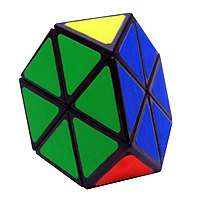
There are several variations of the puzzle. The simplest, Tetraminx, is equivalent to the (3x) Pyraminx but without the tips (see photo). There also exist "higher-order" versions, such as the 4x Master Pyraminx (see photos) and the 5x Professor's Pyraminx.
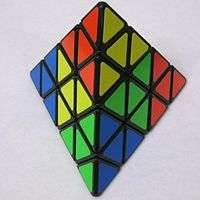
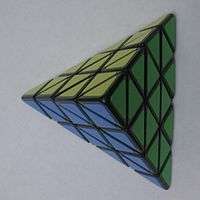
The Master Pyraminx has 4 layers and 16 triangles-per-face (compared to 3 layers and 9 triangles-per-face of the original), and is based on the Skewb Diamond mechanism. This version has about 2.6817 × 1015 combinations.[7][8] The Master Pyraminx has
- 4 "tips" (same as the original Pyraminx)
- 4 "middle axials" (same as the original Pyraminx)
- 4 "centers" (similar to Rubik's Cube, none in the original Pyraminx)
- 6 "inner edges" (similar to Rubik's Cube, none in the original Pyraminx)
- 12 "outer edges" (2-times more than the 6 of the original Pyraminx)
In summary, the Master Pyraminx has 30 "manipulable" pieces. However, like the original, 8 of the pieces (the tips and middle axials) are fixed in position (relative to each other) and can only be rotated in place. Also, the 4 centers are fixed in position and can only rotate (like the Rubik's Cube). So there are only 18 (30-8-4) "truly movable" pieces; since this is 10% fewer than the 20 "truly movable" pieces of the Rubik's Cube, it should be no surprise that the Master Pyraminx has about 10,000-times fewer combinations than a Rubik's Cube (about 4.3252 × 1019[9]).
See also
- Pyraminx Duo
- Pyramorphix and Master Pyramorphix, two regular tetrahedron puzzles which resemble the Pyraminx but are mechanically very different from it
- Pocket Cube
- Rubik's Cube
- Rubik's Revenge
- Professor's Cube
- V-Cube 6
- V-Cube 7
- V-Cube 8
- Skewb
- Skewb Diamond
- Megaminx
- Dogic
- Combination puzzles
- Tower Cube
References
- http://www.mefferts.com/puzzles-pyraminx-kokonotsu.htm
- Pyraminx - Jaap's Puzzle Page
- "Pyraminx - Official World Records (Single and Average)". World Cube Association. Retrieved 6 April 2019.
- World Cube Association Official Pyraminx Ranking Single
- World Cube Association Official Pyraminx Ranking Average
- World Cube Association - Drew Brads results.
- "Full List of Puzzles". gandreas software. Archived from the original on 28 April 2016. Retrieved 31 December 2016.
- "Notes on Twisty Puzzles". Michael Gottlieb. Retrieved 31 December 2016.
- Martin Schönert "Analyzing Rubik's Cube with GAP": the permutation group of Rubik's Cube is examined with GAP computer algebra system
External links
| Wikimedia Commons has media related to Pyraminx. |
- Jaap's Pyraminx and related puzzles page, with solution
- Pyraminx solution from PuzzleSolver
- A solution to the Pyraminx by Jonathan Bowen
- An efficient and easy to follow solution favoured by speed solvers
- Patterns A collection of pretty patterns for the Pyraminx
